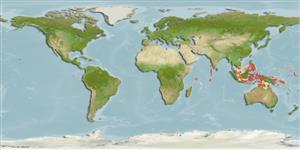Classification / Names
Common names from other countries
Main reference
Size / Weight / Age
Max length : 6.0 cm SL male/unsexed; (Ref. 48637)
Environment
Marine; reef-associated, usually 15 - 25 m (Ref. 27115)
Climate / Range
Tropical; 22°C - 25°C (Ref. 27115), preferred ?; 15°N -
Distribution
Short description
Dorsal
spines
(total): 7;
Dorsal
soft rays
(total): 12;
Anal
spines: 1;
Anal
soft rays: 11;
Vertebrae: 26. Bright yellow from top of head to chin including most of iris; 2nd dorsal fin and caudal fin translucent yellow, both with diffuse light blue submarginal band and 4-5 rows of elliptical dark-edged blue spots; anal and pointed pectoral fins with yellowish rays. Naked thorax and pectoral base. Head pores absent. Dark head band ending on lower margin of preoperculum. Median predorsal region naked. Eye and mouth large. Angle of jaws 25 degrees. Longitudinal scale series 84, transverse 21. 1st 2 elongated spines and its membrane black.
IUCN Red List Status (Ref. 115185)
Threat to humans
Harmless
Human uses
Aquarium: commercial
More information
Common namesSynonymsMetabolismPredatorsEcotoxicologyReproductionMaturitySpawningFecundityEggsEgg development
ReferencesAquacultureAquaculture profileStrainsGeneticsAllele frequenciesHeritabilityDiseasesProcessingMass conversion
Tools
Special reports
Download XML
Internet sources
Estimates of some properties based on models
Phylogenetic diversity index
PD50 = 0.5078 many relatives (e.g. carps) 0.5 - 2.0 few relatives (e.g. lungfishes)
Trophic Level
3.3 ±0.3 se; Based on size and trophs of closest relatives
Resilience
High, minimum population doubling time less than 15 months (Preliminary K or Fecundity.)
Vulnerability
Low vulnerability (16 of 100)
Price category
